DIY Fixes for Common Pool Problems: Leaks, Cloudy Water, and More
Are you tired of dealing with pesky pool problems that seem to pop up just when you want to take a dip? Leaks, cloudy water, and other issues can quickly put a damper on your pool season. But fear not, because, in this discussion, we will explore some simple DIY fixes that can help you tackle these common pool problems head-on. Whether you’re trying to locate and fix a leak, clear up cloudy water, or troubleshoot your pool filters, we’ve got you covered. So, dive in and discover how you can keep your pool in tip-top shape all summer long.
Key Takeaways
- Visual inspection and testing techniques such as dye testing and bucket testing can help detect and repair pool leaks.
- Clearing cloudy pool water involves vacuuming debris, using clarifiers, backwashing the filter, and maintaining proper water chemistry.
- Troubleshooting and repairing pool filters may involve cleaning or replacing the filter, clearing obstructions or replacing pipes, adjusting pump speed or valve settings, tightening fittings, or replacing damaged parts.
- Algae elimination and prevention can be achieved through regular maintenance practices such as brushing and vacuuming, proper filtration and circulation, maintaining chemical balance, and using algaecide treatments.
Finding and Fixing Pool Leaks
To find and fix pool leaks, you need to employ a systematic approach that will help you identify and resolve the issue efficiently. One common problem pool owners face is detecting hidden leaks. These leaks can be tricky to locate, but there are a few methods you can try. First, perform a visual inspection of the pool and its surroundings. Look for any signs of water damage or wet spots near the pool equipment or in the yard. You can also conduct a dye test by adding food coloring to the water near suspected leak areas. If the dye gets sucked into a crack or crevice, it indicates a leak. Another method is using a bucket test. Fill a bucket with water and mark the water level inside and outside the bucket. Place the bucket in the pool and let it float for 24 hours. If the water level inside the bucket drops more than the level outside, there may be a leak. Once you have detected the leak, you can proceed to patching small leaks. Use a pool patch kit to seal the leak. Clean the area around the leak, apply the patch according to the instructions, and smooth it out. Allow the patch to cure for the recommended time before refilling the pool. By following these steps, you can effectively detect and patch small leaks in your pool.
Clearing Cloudy Pool Water
If your pool water appears cloudy, there are several steps you can take to effectively clear it up.

- Vacuuming debris: Start by using a pool vacuum to remove any debris that may be contributing to the cloudiness. Make sure to thoroughly clean the pool floor and walls, paying special attention to corners and crevices where debris can accumulate.
- Treating with clarifiers: Adding a clarifying agent to your pool water can help to coagulate and remove small particles that are causing cloudiness. Follow the manufacturer’s instructions for the appropriate dosage and application method. Be sure to run the pool filter for several hours after adding the clarifier to help it distribute evenly.
- Backwashing the filter: If your pool has a sand or DE filter, backwashing can help remove trapped debris and improve filtration. Follow the manufacturer’s instructions for your specific filter type to ensure proper backwashing technique.
- Balancing the water chemistry: Cloudy water can sometimes be a result of imbalanced water chemistry. Test the water regularly and adjust the pH, alkalinity, and sanitizer levels as needed. Proper water balance will help prevent cloudiness and other water quality issues.
Troubleshooting and Repairing Pool Filters
When troubleshooting and repairing pool filters, it is important to accurately identify the problem before attempting any repairs. Proper pool filter maintenance is crucial for keeping your pool clean and clear of debris. Common filter issues can include a decrease in water flow, leaks, and dirty or clogged filters. To help you troubleshoot and repair these problems, refer to the table below:
| Problem | Possible Causes | Solutions |
| Decreased water flow | Blocked or dirty filter | Clean or replace the filter |
| Clogged or damaged pipes | Clear obstructions or replace pipes | |
| Low pump speed | Increase pump speed | |
| Incorrect valve position | Adjust valve settings | |
| Leaks | Loose or damaged fittings | Tighten fittings or replace if needed |
| Cracked or broken filter tank | Replace the filter tank | |
| Damaged o-ring or gasket | Replace the o-ring or gasket | |
| Dirty or clogged | Excessive debris | Backwash or clean the filter |
| filters | Improper filter media | Replace or replenish the filter media |
| Incorrect filter size | Install the correct size filter |
Eliminating Algae and Preventing Outbreaks
Looking to eliminate algae and prevent outbreaks in your pool? Algae growth can make your pool water look unappealing and pose health risks. Luckily, there are effective methods to prevent algae growth and keep your pool clean and clear. Here are four algae control methods you can try:

- Regular brushing and vacuuming: Brushing the pool walls and floor and vacuuming the debris can remove any algae spores that may be present.
- Proper filtration and circulation: Make sure your pool’s filtration system is working efficiently to remove any debris or algae particles. Additionally, ensure good water circulation to prevent stagnant areas where algae can thrive.
- Proper chemical balance: Maintain the correct pH and chlorine levels in your pool. Low chlorine levels can allow algae to grow, while high levels can irritate swimmers. Regularly test and adjust the chemical balance to prevent algae outbreaks.
- Algaecide treatments: Using an algaecide can help prevent algae growth. Choose an algaecide that is suitable for your pool type and follow the manufacturer’s instructions for application.
Maintaining Proper Pool Chemical Balance
Maintain the proper chemical balance in your pool to prevent algae growth and ensure a clean and healthy swimming environment. Testing the water regularly is crucial for maintaining the right chemical balance. Use a testing kit to check the pH, chlorine, and alkalinity levels. The pH level should be between 7.2 and 7.6 for optimal swimming conditions. If the pH is too low, add pH increaser; if it’s too high, add pH decreaser. Chlorine is essential for killing bacteria and preventing algae growth. Aim for a chlorine level of 1-3 ppm (parts per million). If the chlorine level is low, add chlorine tablets or liquid chlorine. Alkalinity is important because it helps stabilize the pH level. It should be between 80-120 ppm. If the alkalinity is too low, add alkalinity increaser; if it’s too high, add alkalinity decreaser. Another aspect of maintaining chemical balance is preventing scale buildup. Scale forms when the calcium level in the water is too high. To prevent scale, add a scale inhibitor to the pool water regularly. By keeping a close eye on the chemical balance and preventing scale buildup, you can ensure a safe and enjoyable swimming experience for everyone.
Learn more about balancing the chemical balance in your pool.
Frequently Asked Questions
How Can I Increase the Water Flow in My Pool Filter?
To increase water flow in your pool filter, start by checking for any clogs or debris. Clean the filter and backwash it if necessary. If the problem persists, consult a professional for further troubleshooting of your pool pump.
What Should I Do if My Pool Water Is Green and Slimy?
If your pool water is green and slimy, it could be caused by algae growth. Effective treatments include shocking the pool with chlorine and algaecide, scrubbing the walls and floor, and maintaining proper chemical balance.
Can I Use Household Bleach to Balance the Chlorine Levels in My Pool?
Yes, you can use household bleach to balance the chlorine levels in your pool. It’s a cost-effective option, but be cautious as bleach may contain additives that can harm your pool equipment.
How Often Should I Backwash My Pool Filter?
You should backwash your pool filter regularly to prevent clogging. Signs of a clogged filter include reduced water flow and cloudy water. Backwashing frequency depends on usage, but once a week is a good starting point.
Is It Possible to Fix a Pool Leak Without Draining the Entire Pool?
Yes, it is possible to fix a pool leak without draining the entire pool. Pool leak detection methods can help locate the leak, and temporary fixes like pool putty or adhesive patches can be applied.


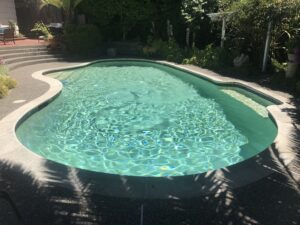

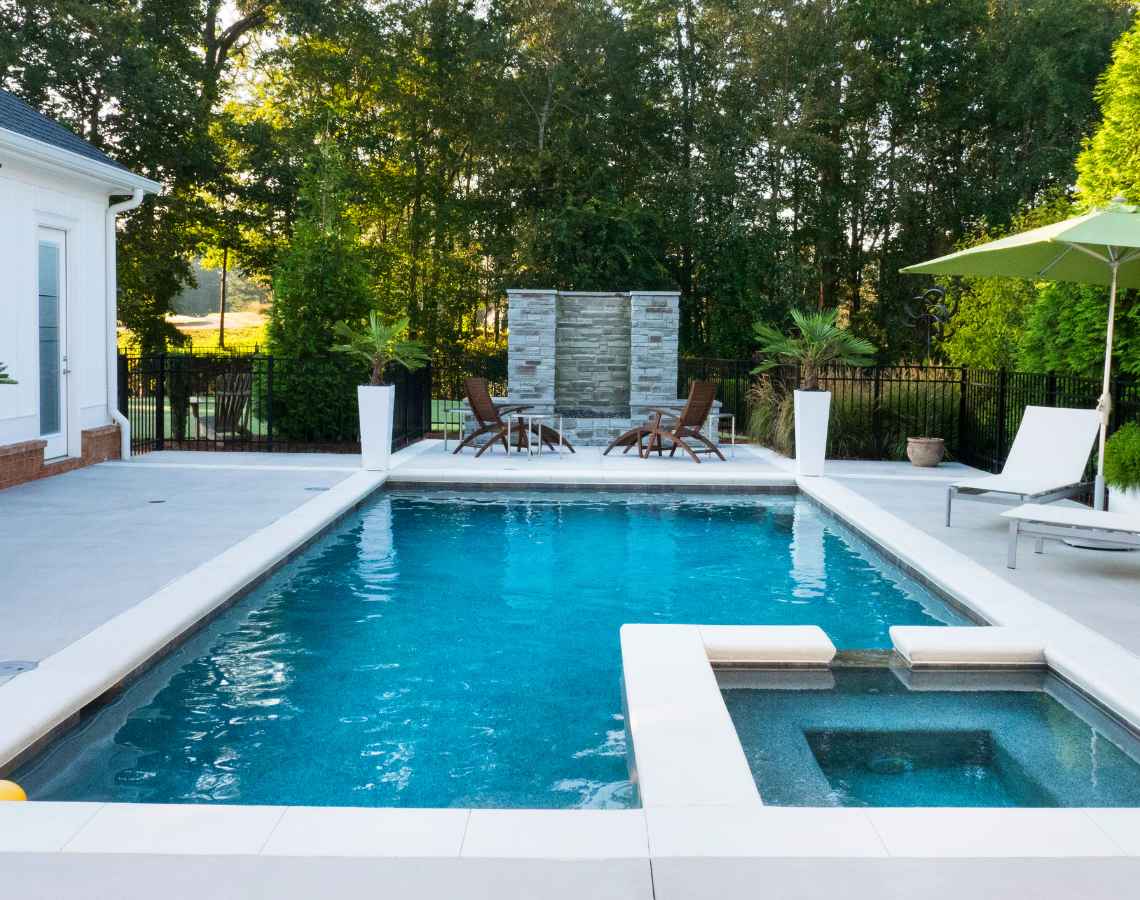

 Alex Cota
Alex Cota  Sophie Pekic
Sophie Pekic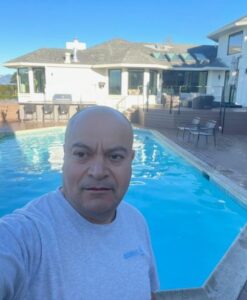 Rudy Reyes
Rudy Reyes  Mark Harlan
Mark Harlan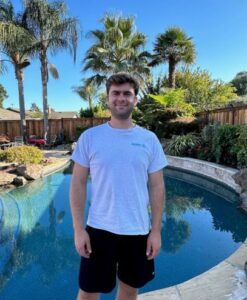 Kevin Hall
Kevin Hall 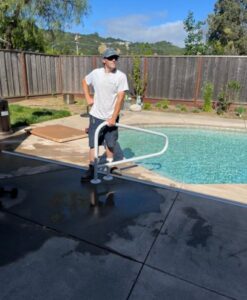 Howard (Howie) Van Lare
Howard (Howie) Van Lare  Chris Cavalerro
Chris Cavalerro 

 Betty Garmendina
Betty Garmendina George Wallace
George Wallace Zach Zastrow
Zach Zastrow Jorge Salazar Bernal
Jorge Salazar Bernal Mike Watson
Mike Watson Jane Ciuchta – Hired 2015
Jane Ciuchta – Hired 2015 Bruce Muir – Hired 2020
Bruce Muir – Hired 2020 David-Metzger – Hired 2014
David-Metzger – Hired 2014 Robin Clarke – Hired 2019
Robin Clarke – Hired 2019 Maddi Davidson – Hired 2022
Maddi Davidson – Hired 2022 John Albachten – Hired 2015
John Albachten – Hired 2015 Jay Bergmann – Hired 2023
Jay Bergmann – Hired 2023 Summer Venegas – Hired 2017
Summer Venegas – Hired 2017 Rebecca Jones – Hired 2015
Rebecca Jones – Hired 2015 Jane Doe – Hired 2014
Jane Doe – Hired 2014